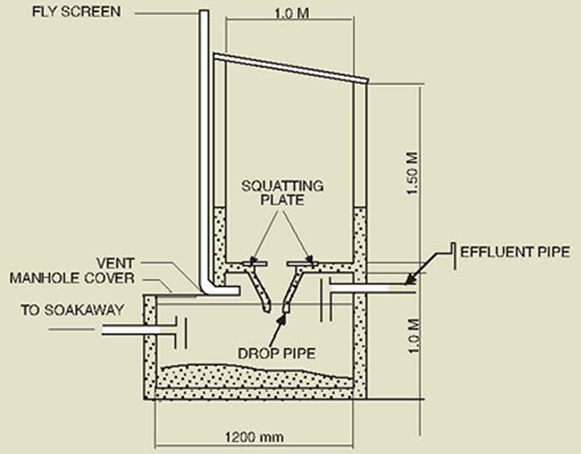Septic Tank
|
|||||||||||||||||||||||||||
A septic tank is a watertight chamber made of concrete, fibreglass, PVC or plastic, through which blackwater and greywater flows for primary treatment. Settling and anaerobic processes reduce solids and organics, but the treatment is only moderate.
Liquid flows through the tank and heavy particles sink to the bottom, while scum (mostly oil and grease) floats to the top. Over time, the solids that settle to the bottom are degraded anaerobically. However, the rate of accumulation is faster than the rate of decomposition, and the accumulated sludge and scum must be periodically removed. The effluent of the septic tank must be
dispersed by using a Soak Pit (D.7) or Leach Field (D.8), or transported to another treatment technology via a [[Solids-free Sewer
| Solids-Free Sewer]] (C.5). Generally, the removal of 50% of solids, 30 to 40% of BOD and a 1-log removal of E. coli can be expected in a well-designed and maintained septic tank, although efficiencies vary greatly depending on operation and maintenance and climatic conditions.
Contents
Design Considerations
A septic tank should have at least two chambers. The first chamber should be at least 50% of the total length, and when there are only two chambers, it should be two thirds of the total length. Most of the solids settle out in the first chamber. The baffle, or the separation between the chambers, is to prevent scum and solids from escaping with the effluent. A T-shaped outlet pipe further reduces the scum and solids that are discharged. Accessibility to all chambers (through access ports) is necessary for maintenance.
Septic tanks should be vented for controlled release of odorous and potentially harmful gases. The design of a septic tank depends on the number of users, the amount of water used per capita, the average annual temperature, the desludging frequency and the characteristics of the wastewater. The retention time should be 48 hours to achieve moderate treatment.
A variation of the septic tank is called an Aquaprivy. This is a simple storage and settling tank that is located directly below the toilet so that the excreta fall into it. The Aquaprivy has a low treatment efficiency.
| Advantages | Disadvantages/limitations |
|---|---|
| - Simple and robust technology - No electrical energy is required |
- Low reduction in pathogens, solids and organics - Regular desludging must be ensured |
Appropriateness
This technology is most commonly applied at the household level. Larger, multi-chamber septic tanks can be designed for groups of houses and/ or public buildings (e.g., schools). A septic tank is appropriate where there is a way of dispersing or transporting the effluent. If septic tanks are used in densely populated areas, onsite infiltration should not be used, otherwise, the ground will become oversaturated and contaminated, and wastewater may rise up to the surface, posing a serious health risk. Instead, the septic tanks should be connected to some type of Conveyance technology, through which the effluent is transported to a subsequent Treatment or Disposal site.
Even though septic tanks are watertight, it is not recommended to construct them in areas with high groundwater tables or where there is frequent flooding. Because the septic tank must be regularly de-sludged, a vacuum truck should be able to access the location. Often, septic tanks are installed in the home, under the kitchen or bathroom, which makes emptying difficult.
Septic tanks can be installed in every type of climate, although the efficiency will be lower in colder climates. They are not efficient at removing nutrients and pathogens.
Health Aspects/Acceptance
Under normal operating conditions, users do not come in contact with the influent or effluent. Effluent, scum and sludge must be handled with care as they contain high levels of pathogenic organisms. Users should be careful when opening the tank because noxious and flammable gases may be released.
Operation & Maintenance
Because of the delicate ecology, care should be taken not to discharge harsh chemicals into the septic tank. Scum and sludge levels need to be monitored to ensure that the tank is functioning well. Generally, septic tanks should be emptied every 2 to 5 years. This is best done by using a Motorized Emptying and Transport technology (C.3), but Human-Powered Emptying (C.2) can also be an option. Septic tanks should be checked from time to time to ensure that they are watertight.
Field experiences
 TESO North School and Community WASH Project |
 Basic Sanitation for Loja Province |
Manuals, videos, and links
This document lists the specifications that need to be met for a succesful Aqua Privy.
References
- Crites, R. and Tchobanoglous, G. (1998). Small and Decentralized Wastewater Management Systems. WCB/McGraw- Hill, New York, US.
- Mara, D. D. (1996). Low-Cost Urban Sanitation. Wiley, Chichester, UK. (Sizing, volume and emptying calculations and example
design solutions – Chapter 6)
- Oxfam (2008). Septic Tank Guidelines. Technical Brief. Oxfam GB, Oxford, UK.
- Available at: policy-practice.oxfam.org.uk
- Polprasert, C. and Rajput, V. S. (1982). Environmental Sanitation Reviews. Septic Tank and Septic Systems. Environmental Sanitation Information Center, AIT, Bangkok, TH. pp. 68-74. (Comprehensive design manual)
- Ulrich, A. (Ed.), Reuter, S. (Ed.), Gutterer, B. (Ed.), Sasse, L., Panzerbieter, T. and Reckerzügel, T. (2009). Decentralised Wastewater Treatment Systems (DEWATS) and Sanitation in Developing Countries. A Practical Guide. WEDC, Loughborough University, Leicestershire, UK.
Acknowledgements
The material on this page was adapted from:
Elizabeth Tilley, Lukas Ulrich, Christoph Lüthi, Philippe Reymond and Christian Zurbrügg (2014). Compendium of Sanitation Systems and Technologies, published by Sandec, the Department of Water and Sanitation in Developing Countries of Eawag, the Swiss Federal Institute of Aquatic Science and Technology, Dübendorf, Switzerland.
The 2nd edition publication is available in English. French and Spanish are yet to come.



